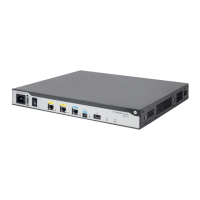44
Step Command Remarks
5. (Optional.) Specify gateways.
gateway-list
ip-address&<1-8>
By default, no gateway is
specified.
Specifying a domain name suffix for DHCP clients
You can specify a domain name suffix in a DHCP address pool on the DHCP server. With this suffix
assigned, the client only needs to input part of a domain name, and the system adds the domain
name suffix for name resolution. For more information about DNS, see "Configuring DNS."
T
o configure a domain name suffix in the DHCP address pool:
Step Command Remarks
1. Enter system view.
system-view
N/A
2. Create a DHCP address pool
and enter its view.
dhcp server ip-pool
pool-name
By default, no DHCP address
pool exists.
3. Specify a domain name suffix.
domain-name
domain-name
By default, no domain name is
specified.
Specifying DNS servers for DHCP clients
To access hosts on the Internet through domain names, a DHCP client must contact a DNS server to
resolve names. You can specify up to eight DNS servers in a DHCP address pool.
To specify DNS servers in a DHCP address pool:
Step Command Remarks
1. Enter system view.
system-view
N/A
2. Create a DHCP address pool
and enter its view.
dhcp server ip-pool
pool-name
By default, no DHCP
address pool exists.
3. Specify DNS servers.
dns-list
ip-address&<1-8>
By default, no DNS server is
specified.
Specifying WINS servers and NetBIOS node type for DHCP
clients
A Microsoft DHCP client using NetBIOS protocol must contact a WINS server for name resolution.
You can specify up to eight WINS servers for such clients in a DHCP address pool.
In addition, you must specify a NetBIOS node type for the clients to approach name resolution. There
are four NetBIOS node types:
• b (broadcast)-node—A b-node client sends the destination name in a broadcast message.
The destination returns its IP address to the client after receiving the message.
• p (peer-to-peer)-node—A p-node client sends the destination name in a unicast message to
the WINS server. The WINS server returns the destination IP address.
• m (mixed)-node—An m-node client broadcasts the destination name. If it receives no
response, it unicasts the destination name to the WINS server to get the destination IP address.
• h (hybrid)-node—An h-node client unicasts the destination name to the WINS server. If it
receives no response, it broadcasts the destination name to get the destination IP address.

